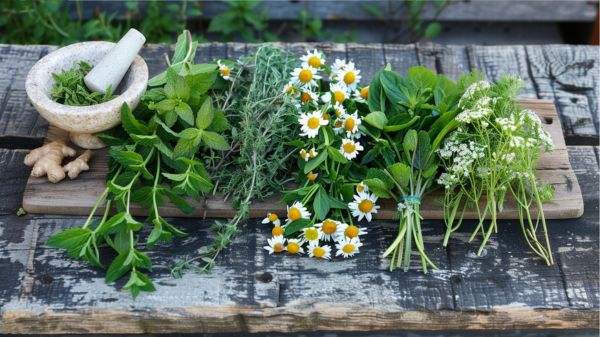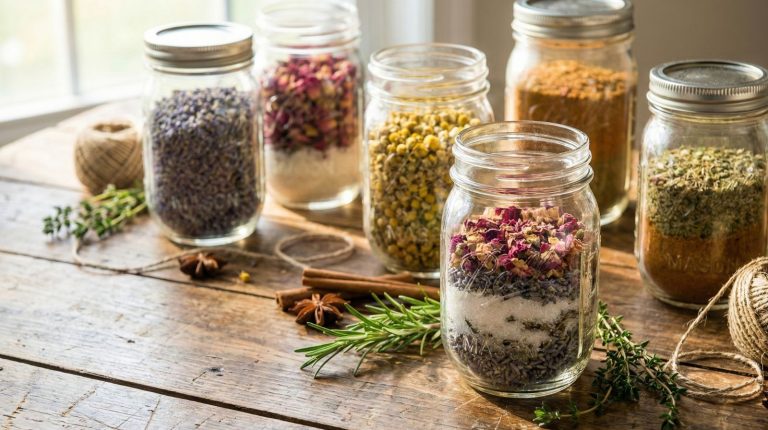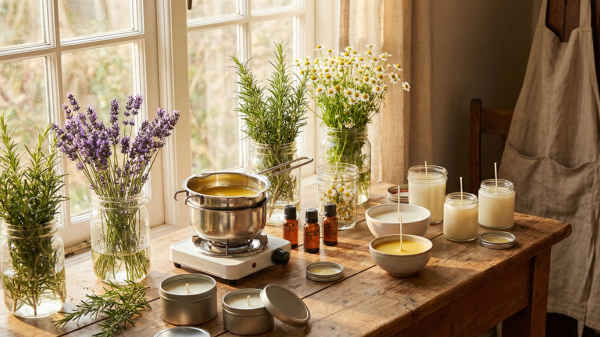In the domain of natural health, the ability to identify common medicinal herbs and their uses is essential. As we explore the historical applications and modern validations of these plants, it becomes clear that understanding their properties is vital for maximizing health benefits.
However, the process of distinguishing beneficial herbs from their potentially harmful counterparts can be intricate. This raises a pivotal question: how can one guarantee they are harnessing the therapeutic powers of herbs safely and effectively? As we examine the steps for proper identification and usage, the importance of expert guidance becomes unmistakably evident.
Key Takeaways
- Utilize field guides or mobile apps to accurately identify medicinal herbs and distinguish them from harmful look-alikes.
- Learn identification through workshops with local herbalists, focusing on leaf shape, flower color, and preferred habitats.
- Prepare herbs using appropriate techniques: dry for storage, create tinctures with alcohol, or brew teas and decoctions.
- Understand common uses: Echinacea for immune support, Ginger for nausea, and Turmeric for anti-inflammatory purposes.
- Consult healthcare providers about potential interactions and safety, especially when combining herbal remedies with prescription medications.
Historical Background of Herbs
The historical use of medicinal herbs is both profound and pervasive, stretching back to ancient civilizations and documented in early texts such as the Ebers Papyrus from Egypt around 1550 BC. This document, among others, demonstrates the long tradition of herbal medicine, showing how cultures around the world have consistently used botanicals to treat health conditions.
Traditional Chinese Medicine (TCM), for example, has relied on a complex system of medicinal herbs for thousands of years, emphasizing the holistic nature of healing both the body and mind. Indigenous cultures globally have also played a pivotal role in the utilization and preservation of herbal knowledge, using local plants not only for physical ailments but often in spiritual practices as well.
This deep-rooted connection underscores the importance of understanding both the safety and efficacy of each medicinal herb used. Today, the relevance of herbal medicine remains strong, with approximately 25% of modern pharmaceuticals derived from plants.
In addition, the World Health Organization notes that about 80% of the global population still relies on botanical medicine as a primary form of healthcare, highlighting the enduring value and trust in plant-based treatments across diverse communities.
Identifying Medicinal Herbs
Understanding the historical context and widespread use of medicinal herbs sets the stage for practical learning about these plants today. Identifying medicinal herbs accurately is essential not only for their effective use but also to guarantee safety, given the presence of look-alike plants.
The journey to master the identification of these beneficial plants begins with the keen observation of their distinct characteristics.
| Characteristic | Example |
|---|---|
| Leaf Shape | Heart (Viola) |
| Flower Color | Yellow (St. John’s Wort) |
| Growth Habit | Creeping (Thyme) |
| Preferred Habitat | Moist (Marshmallow) |
| Look-alike Danger | Wild Carrot vs. Poison Hemlock |
Using reliable field guides or sophisticated mobile apps helps to differentiate between similar species by providing detailed images and descriptions. This technology complements traditional methods and offers a modern approach to plant identification.
Furthermore, connecting with local herbalists and participating in workshops can deepen your understanding and ability to identify medicinal herbs safely. These experts provide practical insights and firsthand experiences that are invaluable. They highlight essential aspects such as habitat preferences and how to distinguish between beneficial plants and their dangerous counterparts, guaranteeing a holistic and secure approach to herbal identification.
Related Post: Top 5 Apps for Medicinal Herb Identification.
Preparation Techniques for Herbs
Several preparation techniques for medicinal herbs are essential for maximizing their therapeutic benefits and ensuring their viability over time. Properly preparing herbs not only preserves their medicinal properties but also enhances the delivery of these benefits to the body.
Here are some effective methods:
- Drying: This method is important for extending the shelf life of herbs while retaining their active compounds and flavors. Drying allows for the preservation of herbs for use throughout the year, especially when fresh plants are not available.
- Tinctures: By soaking herbs in alcohol or vinegar, tinctures extract and concentrate the medicinal properties of the plants. This preparation results in a potent liquid that can be used in small, manageable doses to address a variety of health issues.
- Decoctions and Infusions: These techniques involve either simmering tougher plant parts, like roots and barks (decoctions), or infusing lighter parts like leaves and flowers in hot water (herbal teas). Both methods are effective in extracting beneficial compounds from the herbs.
Additionally, exploring the use of natural pain relievers like cayenne pepper or turmeric in these preparations can further enhance their pain-relieving properties.
Whether creating herbal teas, developing tinctures, or formulating topical applications like salves, each method plays a significant role in holistic health practices, offering a tailored approach to wellness and the liberation from conventional medicine constraints.
Common Uses of Medicinal Herbs
Medicinal herbs have been harnessed by various cultures for centuries, addressing a spectrum of ailments and promoting overall health. Among the most commonly used is Echinacea, prized for its immune-boosting capabilities. Studies suggest it can reduce the duration of colds and flu if administered promptly at the onset of symptoms.
Another crucial herb, Ginger, is celebrated for its efficacy in alleviating nausea. It’s especially effective for treating morning and motion sickness, providing relief with minimal side effects.
Turmeric, with its active compound curcumin, offers significant anti-inflammatory benefits. It is commonly used to manage arthritis and chronic pain, making it a cornerstone in natural remedies for its therapeutic properties.
Lavender, known for its calming effects, aids in reducing anxiety and enhancing sleep quality. Its use in aromatherapy or as a tea is supported by various studies highlighting its effectiveness.
Chamomile rounds out these herbal powerhouses with its dual ability to soothe digestive issues and promote better sleep through its anti-inflammatory and calming effects.
Each of these herbs contains unique plant compounds that contribute to their health benefits, providing additional information on the vast potential of herbal remedies in natural health practices.
Related Post: Eight Effective Strategies for Preserving Medicinal Herbal Plants.
Safety and Interactions
While herbal medicines are often considered a safer alternative to synthetic drugs due to their natural origins, they can still pose significant health risks including serious side effects and interactions with other medications.
The allure of herbal medicine often stems from its historical use and perceived gentleness, yet this does not exempt it from rigorous scrutiny for safety and potential interactions. For instance, herbal remedies used for chronic diseases like turmeric and ginger are recognized for their anti-inflammatory properties, but can also interact with blood thinners, altering their effectiveness.
Key considerations include:
- St. John’s Wort: This herb can decrease the effectiveness of medications such as antidepressants, birth control pills, and anticoagulants, which may lead to severe health consequences.
- Pregnancy and Breastfeeding: Certain herbs and essential oils may harm fetal or infant health, necessitating heightened caution among pregnant or breastfeeding individuals.
- Disclosure to Healthcare Providers: It is crucial to inform healthcare providers about all herbal supplements being used. This disclosure helps prevent dangerous drug interactions and guarantees a holistic approach to health management.
The intersection of herbal supplements and conventional medications demands careful consideration and consultation with healthcare professionals to navigate safely.
Understanding the complexities of how herbal products interact with other medications underscores the importance of informed, cautious use to optimize health outcomes while minimizing risks.
Future Trends in Herbal Medicine
The landscape of herbal medicine is evolving rapidly, marked by increased regulatory measures and a shift toward integrating these ancient practices with modern medical research. In parts of Europe, herbs are now classified similarly to prescription medications, a move designed to guarantee safety and effectiveness.
This regulatory framework supports the growth of collaborative research, which bridges the gap between traditional botany and pharmacology, aiming to uncover potent, new natural remedies.
Medical and pharmacy schools are responding to this shift by weaving herbal medicine studies into their curricula, thereby equipping future healthcare professionals with the knowledge to integrate herbal solutions into thorough treatment plans.
This educational trend underscores a broader acceptance of herbal methods, particularly for conditions like the common cold or to treat insomnia and anxiety, where patients often rely on herbal medicines alongside conventional drugs.
Additionally, the focus on promising results in treating chronic conditions like arthritis and asthma with herbal remedies is gaining significant attention, highlighting their potential in mainstream medical practices.
Furthermore, the rising consumer interest in self-care and holistic approaches fuels the demand for herbal products. People increasingly prefer integrated treatment plans that combine the wisdom of traditional herbal practices with modern medical interventions, fostering a more holistic, patient-centered approach to health.
This trend is setting the stage for a future where herbal and conventional treatments coexist seamlessly, enhancing therapeutic outcomes across the board.
Related Post: 10 Powerful Medicinal Plants: The Forgotten Ancient Healing Herbs.
Conclusion
In summary, the proper identification and usage of medicinal herbs are pivotal for harnessing their health benefits. By integrating historical knowledge with modern identification tools and preparation techniques, individuals can effectively utilize these natural remedies.
Awareness of safety and potential interactions guarantees responsible use. As interest in herbal medicine grows, continued education and technological advancements are anticipated to further enhance the efficacy and safety of herbal practices, contributing to holistic health approaches globally.




